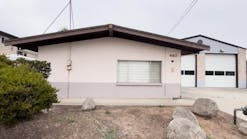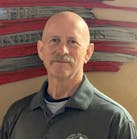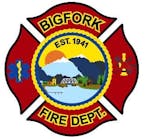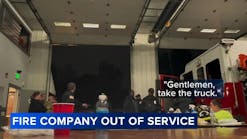PA Volunteer Shortage Means FFs Live Rent Free at Stations
By Kayla Dwyer
Source The Morning Call
The lounge could pass for a college dorm, ignoring the vintage fire hats, canvass jackets and 1992 training record board hanging on the walls.
Half-empty Gatorade bottles and binders sit on end tables next to plush couches the twenty-somethings who live there found on the side of a road. They’ve got a PlayStation system and a kitchenette that, admittedly, they don’t use often, opting for fast food instead.
Inside the bunk room, a strobe light on the ceiling illuminates with a rapid high-pitched beep — but this light isn’t a prop for late-night parties.
It alerts the volunteer firefighters who live there of a fire call.
Within three minutes, live-in volunteers Jake Gallich, 22, Nick Bosga, 25, and Jake Serfass, 19, would be suited up and out the door of Fogelsville Volunteer Fire Co. in Upper Macungie Township.
To them, the setup feels just like college. Sleep comes in spurts, and the live-ins are close, like brothers. This was part of the allure of a 2-year-old program that gives the men free rent at the firehouse in exchange for 40 hours of volunteer fire service.
“I joined here and it kind of became like a family,” said Serfass, who spends 40 daylight hours a week at the Lehigh County 9-1-1 center.
To Chief Doug Gernerd, a fourth-generation firefighter in the century-old station, it’s a lifeline, if a temporary one.
“This is a Band-Aid,” he said, and the live-in program is only half-full. “We need help. Everybody needs help.”
A joke above the bunk room door, “UMT’s Most Hated," is an homage to how quickly Fogelsville’s live-in volunteers can get to fire scenes ahead of other fire companies. And it’s a reminder to Gernerd of the reason they built the program in the first place: the desperate need for more volunteers, especially younger ones.
Before the program, at Fogelsville, the average age of volunteers responding to calls after midnight was about 60, Gernerd said. It took volunteers responding at home double the time to get the first apparatus out the door. With homes burning hotter and faster because of the increased use of synthetic material, those minutes are critical.
“We had to do something,” he said. “It was getting really bad.”
Across the Lehigh Valley and the state, volunteer fire departments — which make up 90% of the state’s fire companies — have been feeling the pain of volunteer shortages for at least a decade. Where the state once had about 300,000 volunteers in the 1970s, it had just 60,000 in the early 2000s, and a mere 38,000 in 2018, according to the Pennsylvania Office of the State Fire Commissioner.
Many get by calling on neighboring departments, and just a few, including Cetronia and Bethlehem Township, have live-in programs to ease the pain. Department merging has already started in other parts of the state, though longstanding tradition and station pride often gets in the way most everywhere else. The few who are volunteering are doing more with less, from fire calls to fundraising.
Local fire chiefs are worried they will reach a breaking point if something doesn’t change. Just before the onset of the coronavirus pandemic, a group of them spanning Lehigh and Northampton counties submitted a request to the state for a study to assess how they can solve this problem, whether through mergers or regionalization.
“We’re past crisis level,” said Whitehall Township fire Chief David Nelson, who worked with that group. “If we don’t do something about it, somebody’s going to get killed, is what it’s going to come down to.”
The shrinking
Most fire chiefs can wax poetic about the good old days when volunteers were plentiful.
“When I first started, it was hard to get everybody on a truck, there were so many volunteers,” said East Allen fire Chief Barry Frantz.
Gernerd remembers Fogelsville’s roster of at least 50 lining up for a picture in the late 1970s, when he started. The economy was such that families perhaps only needed one income to live a comfortable life, and people had more time for volunteering.
When a fire call went out, most of them — at least 30 — would show up. Today, with a roster of around 20, Gernerd said he’s lucky if he gets eight to show up. It varies widely in East Allen Township, where on one day, Frantz might have 10 or 15 show up, and on another, two.
Nelson has only been chief for four years at Whitehall, and in that time has seen his ranks drop from 100 to 85. Only 35 or so are trained to go inside homes, and they average 45 to 55 years old.
“So we look at 10 years from now, where are we going to be?” he said.
During the daytime, when most of the volunteers have full-time jobs elsewhere, only about five or six volunteers are usually available. When there’s a structure fire in Whitehall Township, home to the MacArthur Road commercial district, Nelson wants at least 20.
Many departments have similar testimony. For the most part, they rely on mutual aid — calling neighborhood departments for backup. East Allen formed a collaboration with neighbors Northampton and Allen Township about two and a half years ago, in which all three fire companies respond to one another’s calls every time.
“It has driven up our call volume, but we really don’t have a choice — we need to provide the services,” Frantz said. “It seems to give us temporary relief, but obviously we still need to get people in the door.”
Volunteers haven’t been coming they way they used to, chiefs and experts say, because the demands of work life have changed, and the job of the volunteer firefighter has gotten more difficult.
Families now work two or three jobs to run a household, and they shepherd kids around to sports and extracurriculars, leaving little time for volunteerism.
While there are no minimum training requirements in the state, most local fire companies have them and might require hundreds of hours of training — a far cry from when Nelson, starting out in Iowa in the 1980s, simply threw on the long coat and three-quarter-inch boots and hopped on the side of the engine.
And these days, besides waking up to the pager at 2 a.m., volunteer firefighters are often called upon to help with fundraising, given that the volunteer shortage extends to the auxiliary, too.
“You’re asking a lot for somebody to come in the door, and people just don’t have time anymore,” Frantz said.
Searching for solutions
While mergers might be the sensible solution, grit and generational pride may stand in the way.
“The fire service is so traditionally stuck on, ‘I’m not asking anybody for help,”’ said State Fire Commissioner Bruce Trego, a volunteer fireman of 50 years. “200 years of tradition unimpeded by progress.”
“It’s ego,” Gernerd said, admitting that he, too, doesn’t want to see his station lose its identity.
But he recognizes he and others soon might not have a choice. The service needs to be provided somehow.
“When someone calls 911, they want to see a big red truck pull up in front of their door,” regardless of whose big red truck it is, he said — the name won’t matter.
Their concern has ricocheted in the upper echelons of the state for decades.
There was a state Senate commission in 2004 that produced a report on the issue with 23 recommendations to recruit a volunteer base, such as tax incentives, college tuition credits for volunteers, a state-based retirement fund, and the ability for regions and counties, rather than municipalities, to create fire districts, but it resulted in little legislative change.
Another Senate commission convened in 2018 and produced a report with 27 broad recommendations — broken down into nearly 100 specific ones — outlining many of the same issues and reiterating suggestions for structural change.
Some of the suggestions are encapsulated in legislation still in the works, like a Senate bill that would give counties the ability to establish a public safety authority, like a countywide fire service. Such regionalization would also save taxpayer dollars by allowing companies to share expensive equipment, like million-dollar aerials.
Other priorities in the report include restructuring the volunteer relief association programs so that they aren’t dependent on local tax bases, establishing minimum training requirements across the state and expanding the office of the state fire commissioner.
“I’m seeing more reaction now than we have in the past,” Trego said. He knows of at least eight bills in the works and saw eager participation from the General Assembly in the beginning of this year, and then the pandemic hit.
Moving toward paid staffers isn’t on almost anyone’s priority list, given the cost to taxpayers. A 2001 Pennsylvania Fire and Emergency Services Institute study valued the volunteer fire service statewide at $6 billion. East Allen Township fire did an internal study in the 1990s that found it would cost the taxpayers $2 million a year to man the station and cover payroll and insurance, Frantz said.
To Catasauqua Borough manager Steve Travers, this is the No. 1 issue facing municipalities in the next decade.
Over the last year or two, he and the managers and chiefs of East Allen Township, Hanover Township in Lehigh County, North Catasauqua, Northampton borough were already in discussions about their multi-municipal comprehensive planning when the topic of fire service came up. Nelson, in Whitehall, joined the discussions once he heard about it.
Catasauqua’s fire department is well staffed with a slew of young guys, Travers said. But he knows that could change on a dime, once the young volunteers get deeper into other careers and start families.
The group submitted a letter of intent to the state Department of Community and Economic Development in early March, asking for the state fire commissioner to conduct a study of their departments and determine what solutions would make sense, from mergers to regionalization to fire districts, if that ever becomes possible through legislation.
“15 years ago, you could kinda put your head in the sand and say ‘Yeah we’re doing okay,’” Travers said. “We don’t want to be behind it, we want to be ahead of it.”
Live-in programs
Even if Fogelsville’s live-in program is a Band-Aid, Gernerd said the company’s vitality depends on keeping it running.
Bosga has volunteered in live-in programs since he was 18, and he recruited Gallich and Serfass to Fogelsville’s program. They do projects on trucks at odd times of night when they’re not responding to fire calls.
But can it work elsewhere?
East Allen is looking into the feasibility of a live-in program for the station, Frantz said. The decision for fire departments comes down to whether they have or can build the infrastructure to support it, and whether they live in proximity of colleges to attract students. For the latter reason, Whitehall isn’t considering it, Nelson said.
Live-in programs aren’t a heavy emphasis in the latest Senate commission report, which recommends that “all departments with colleges in their communities should explore live-in programs.”
When Cetronia Fire Department became the first in Lehigh County to build a live-in program about four years ago, it wasn’t entirely due to a dearth of volunteers, Chief Jay Heicklen said. Cetronia looked at it as an opportunity to decrease response time — from six to eight minutes down to 90 seconds, dispatch to door — and as a way of recruiting the most dedicated volunteers.
“This isn’t a hobby, it really is a way of life," he said. "It fits you or it doesn’t.”
Twenty-year-old Robert Wesner knew right away that it did, despite having no family in the business. He moved into Cetronia’s live-in program the night he graduated Parkland High School a year and a half ago. He works the overnight shift at Cetronia ambulance corps for now, but wants to make a career out of firefighting, his dream job.
The six live-ins do everything together, from fire calls to social nights out. And they share the same interest: a high-stakes, action-packed job that also involves helping people.
“It’s the best thing in the world,” Wesner said.
___
(c)2020 The Morning Call (Allentown, Pa.)
Visit The Morning Call (Allentown, Pa.) at www.mcall.com
Distributed by Tribune Content Agency, LLC.








